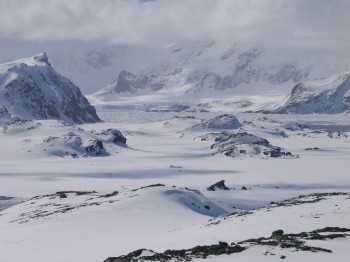
Signy Island, photograph by Michael Dunn
Signy Island is part of the South Orkney Island group, lying on the Scotia Arc in the Maritime Antarctic, approximately 500 km north-east of the Antarctic Peninsula. A relatively small island, with an area of roughly 20 km² and dominated by a central ice cap with permanent snow cover, Signy experiences strong prevailing north-westerly winds all year round and during winter months becomes locked in sea ice, often for up to eight months. Signy has been designated as an Important Bird Area by BirdLife International.
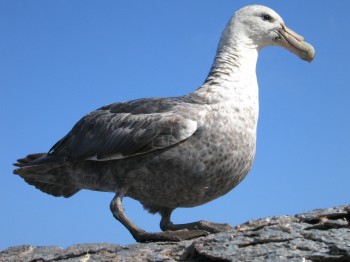

A single ACAP-listed species breeds at Signy Island: the Southern Giant Petrel Macronectes giganteus. Both the dark and the less common white morph of the Southern Giant Petrel breed on the island; about 8% of the adult population is estimated to be of the white phase.
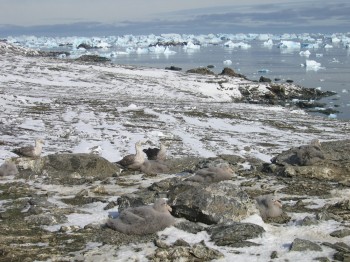
All the breeding sites for this species are found on top of the low-lying cliffs on the western coast of Signy Island. The ground here is gently sloping or relatively flat, made up of a mixed terrain of moss banks, scree slopes and boulder fields. Breeding pairs nest in loose colonies ranging in size from three or four nests to over 70. The most recent census is of 1352 pairs in 2014/15; there were 2351 breeding pairs in 2005/06.
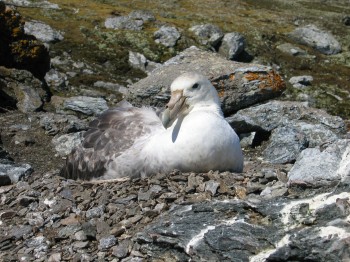
Birds are seen near the colonies all year round. The breeding season at Signy begins in September when adults reoccupy nest sites and ends in May, when the chicks fledge. Nests are constructed either from moss or small stones, depending on the substratum in the immediate vicinity.
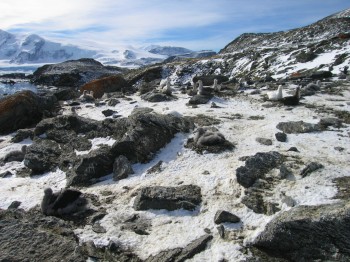
All photographs by Michael Dunn
The population of Southern Giant Petrels at Signy Island is surveyed annually by British Antarctic Survey biologists operating out of a summer research station on the island as part of a long-term monitoring programme. Data have been collected in this way since the mid 1990s and sporadically before that as part of various research projects dating back to the 1940s. The more recent counts suggest that numbers of Southern Giant Petrels breeding at Signy Island have decreased following a period of fluctuations.
Click here to access the ACAP Species Assessment for the Southern Giant Petrel.
With thanks to Richard Phillips, British Antarctic Survey.
Selected References:
Conroy, J.W.H. 1972. Ecological aspects of the biology of the giant petrel Macronectes giganteus (Gmelin) in the maritime Antarctic. British Antarctic Survey Scientific Reports No. 75: 1-74.
Dunn, M.J., Jackson, J.A., Adlard, S. & Phillips, R.A. 2015. Population size and trends of southern giant petrels (Macronectes giganteus) nesting at Signy Island, South Orkney Islands. Polar Biology 39:1309–1317.
Harris, C.M., Lorenz, K., Fishpool, L.D.C., Lascelles, B., Cooper, J., Coria, N.R., Croxall, J.P., Emmerson, L.M., Fijn, R., Fraser, W.L., Jouventin, P., Larue, M.A., Le Maho, Y., Lynch, H.J., Naveen, R., Patterson-Fraser, D.L., Peter, H.-U., Poncet, S., Phillips, R.A., Southwell, C.J., Van Franeker, J.A., Weimerskirch, H., Wienecke, B. & Woehler, E.J. 2015. Important Bird Areas in Antarctica 2015. Cambridge: BirdLife International and Environmental Research & Assessment Ltd. 302 pp.
Patterson, D.L., Woehler, E.J., Croxall, J.P., Cooper, J., Poncet, S. & Fraser, W.R. 2008. Breeding distribution and population status of the Northern Giant Petrel Macronectes halli and the Southern Giant Petrel M. giganteus. Marine Ornithology 36: 115-124.
Rootes, D.M. 1988. The status of birds at Signy Island, South Orkney Islands. British Antarctic Survey Bulletin No. 80: 87-119.
Michael Dunn, British Antarctic Survey, 6 June 2013, updated 13 May 2021

 English
English  Français
Français  Español
Español